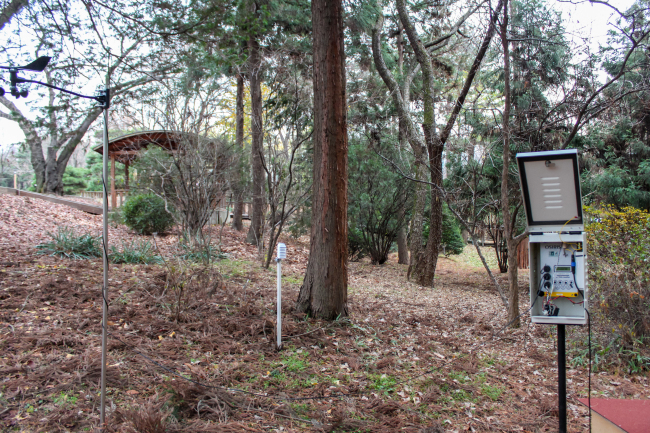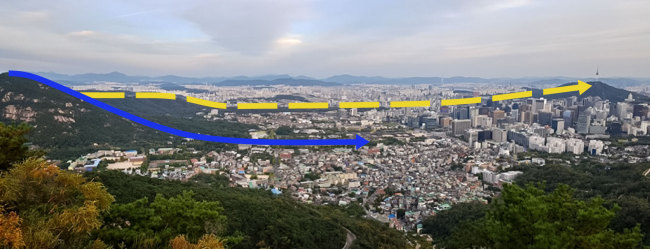[Feature] Forest marketing spreads as fine dust concerns soar
Commercially coined words in housing market should be properly defined: experts
By Yoon Yeun-jungPublished : Dec. 31, 2018 - 12:03
Soaring concerns over ultrafine dust and the overall air quality in South Korea have brought immense changes to the way people now perceive things that were previously taken for granted.
“I have worried about tap water contamination or noise coming from construction sites, but having to worry about the actual air that my children breathe is truly terrifying. There is nowhere to escape,” said Park Min-jeong, a mother of three living in Ilsan, Gyeonggi Province.
That is why a 55-year-old woman, who wished to be identified only as Lim, said she had bought an apartment in Gwacheon, south of Seoul, where she believes the nearby mountains Gwanaksan, Umyeonsan and Cheonggyesan offer some protection.
“I was thinking of leaving Korea because of the fine dust problem. To be honest no matter where I go in Korea, it seems difficult to avoid fine dust. And in Seoul, it’s hard to find a reasonably priced apartment that is close to a forest or a mountain,” Lim said.
Around 83.5 percent of urban dwellers said they were concerned with fine dust, among other environmental problems, according to a report released by Statistics Korea on Nov. 16.
As the fine dust problem started to gain attention as a major social issue in 2017, new trends have emerged in various industries, from face masks claiming to filter out all fine dust particles to enhanced high-tech air purifiers.
The real estate market has been no exception.

In recent years, construction firms have increasingly been promoting new apartment lot sales with the phrase “supsegwon” -- meaning a location adjacent to forests, a geographical feature seemingly helpful in mitigating the damage caused by fine dust.
But such claims, for the time being, come without a specific valuation basis.
“Supsegwon is only used for commercial advertisement. The definition is ambiguous. If it is to be used properly, there needs to be guidelines or consensus regarding the standard distance accessibility between the residential site and the forest, as well as the scale of the nearby forest,” said Park Won-gap, a researcher at KB Kookmin Bank.
Construction company officials contacted by The Korea Herald also admitted to using the phrase supsegwon loosely, in the same vein as the more widely used “yeoksegwon,” meaning a site located nearby a transport hub.
But in the case of yeoksegwon, which is among the most crucial price markers for real estate, there are regulations set by the city of Seoul that stipulate the property be within 500 meters of a subway or train station.
“Regarding fine dust, some companies are implementing the latest technologies for apartments in the construction phase to help lower the level of fine dust. But the correlation between landscaping of the apartment complex and fine dust is something not exactly verified,” a source from one construction firm said.
Obvious benefits of forests
There have been a number of studies that support the benefits of living near forests.
The National Institute of Forest Science says a hectare of forest cuts air pollutants, including fine dust, by 168 kilograms per year. Fine dust and ultrafine dust levels inside Hongneung Arboretum in eastern Seoul, an urban forest covering 35.3 hectares of Dongdaemun-gu, were lower than at locations around 2 kilometers from the forest, according to research conducted by the NIFS in April and May last year. The difference was approximately 26 percent for fine dust and 41 percent for ultrafine dust.
Yet urban forest experts and construction firms say a study has yet to quantitatively show a significant decline in fine dust for apartment complexes near forest or mountain areas.
Urban Forest expert Park Chan-ryul from the NIFS said he was always curious about the term “supsegwon” being used in the real estate sector.
He and his fellow researchers noticed the phrase was commonly used on companies’ websites and online community websites to promote apartment buildings or other types of homes, even if they were simply adjacent to trees or a small park.
“Rather than the term supsegwon, it would be more accurate to say the ‘level of access to urban forest,’ meaning the area is ensured with a minimum amount of forest space that can help make our urban lives more pleasant. The important direction, then, would be to define how much of a forest is minimum,” Park said.
Currently, the World Health Organization recommends 9-15 square meters of total living forest area per person. Compared with other major metropolitan cities like London (27 square meters), New York (23 square meters) and Paris (13 square meters), Seoul is severely lacking in green space, according to Park. Seoul had only 5.35 square meters of living forest area per person as of 2015.

He commented, “Low accessibility to urban forest indicates that actual commuting areas in daily lives are not covered with trees even though the scenery may be full of greenery. Lowering the level of fine dust is closely related with how trees can filter air by functioning as an umbrella shelter.”
To trap the fine dust particles, light and short trees are also helpful, he added.
To really benefit from forests
Another important factor Park stressed is the integration of nature and living space to create the desirable filtering effect.
Many apartment complexes are located next to mountain areas for good views -- a strong factor in determining the price of a home.
But the buildings in fact block wind that can ventilate heated air and fine dust out of the city, Park explained.

The best urban forest model, he said, should have 15-meter-tall trees that are more than 30 years old and that are well linked with the windway from the mountain near the forest. He cited Hongneung Arboretum as a good example.
“Mostly it is difficult to cultivate such big trees in prime urban areas, so a group of 10-meter-tall trees aged around 10 years will have the effect of lowering fine dust just like Seoul Forest Park.”
Professor Shim Gyo-eon from Konkuk University, who is an expert in site planning and real estate development, said, “When we construct complexes, the forest should not only become scenery for the people in urban areas. The forest and parks should be areas where people can enjoy the space, in order for them to be rightfully called supsegwon.”
According to a 2017 Gallup Korea survey of adults living in metropolitan areas, people were willing to pay around 7 percent more for apartments located close to nature in metropolitan areas, particularly in the districts of Gangnam and Gangseo in Seoul.
Supsegwon in cities still a luxury
Real estate agents, meanwhile, point out that being near a forest, or even a lush group of trees, is only important when other key factors in determining the price of an apartment are fulfilled, especially in the cutthroat real estate market of Seoul.
“Almost anywhere within Seoul, any factor that raises the sale price of an apartment is important. Only after those needs are fulfilled, sometimes within the same complex people pay up to an additional 100 million won ($89,000) … for an apartment unit closer to a forest or park,” said real estate agent Choi Min-hee, 58, who has been working for more than 16 years in Gangseo.
The Raemian Gangnam Forest apartment complex in Gangnam and Godeok Lotte Castle Veneluce in the Gangdong district of Seoul both enjoyed strong sales in 2017 due to their emphasis on landscaping and proximity to parks, despite being about 1 kilometer from the nearest subway station.
The parcel price for a 96-square-meter unit of the Raemian ranged from around 1.57 billion won to 1.73 billion won. The parcel price for a 84-square-meter unit at Lotte Castle was around 770 million won.
“They already had other prime factors like being real estate inside Seoul or near prestigious schools, which raises the prices,” commented Choi.
The case has been similar in other regions in Seoul as well.
“When the apartment is already near a subway station, people actually paid an extra 20 million to 30 million won to buy a unit of an apartment closer to forest areas in Eunpyeong-gu,” said real estate agent Lee Yi-suk, 54.
Lee runs a real estate agency in Eunpyeong, a northwestern district near the Bukhansan mountain range and Nokbeon Subway Station in Seoul. The area handled by Lee is popular for its prime location, within the realms of both supsegwon and yeoksegwon.

In early December, a Hillstate Nokbeon Station apartment lot within that prime area drew 11,455 applicants -- about 59 applications per available unit. The parcel price for an 84-square-meter unit ranged from around 500 million won to 700 million won.
“Supsegwon only works for apartment complexes that are already good with transportation, located in the center of the city and with high brand name recognition of the construction company. ... (Supsegwon) is only a premium factor that hikes the sales price of apartments that have already seized the merits of high-demand areas,” professor Shim agreed.
Each season, the local construction and real estate sectors use newly coined terms as part of their marketing technique to target trends, build demand and bolster prices.
Other terms in this fashion have been “haksegwon,” meaning a site located around well-known educational institutions, “beopsegwon,” adjacent to a court or public prosecutors’ office, and “mall-segwon,” near a large shopping complex.
“Supsegwon is just one of the merits that we mention for marketing since more people seem to have interest in green issues. When we are building, the correlation between fine dust and the apartment is not a priority concern we consider. The location (for transportation) and sales price are the most important factors,” a construction industry source said.
By Yoon Yeun-jung (kairos07@heraldcorp.com)








![[KH Explains] Hyundai's full hybrid edge to pay off amid slow transition to pure EVs](http://res.heraldm.com/phpwas/restmb_idxmake.php?idx=644&simg=/content/image/2024/04/18/20240418050645_0.jpg&u=20240419100350)






![[From the Scene] Monks, Buddhists hail return of remains of Buddhas](http://res.heraldm.com/phpwas/restmb_idxmake.php?idx=652&simg=/content/image/2024/04/19/20240419050617_0.jpg&u=20240419175937)

![[KH Explains] Hyundai's full hybrid edge to pay off amid slow transition to pure EVs](http://res.heraldm.com/phpwas/restmb_idxmake.php?idx=652&simg=/content/image/2024/04/18/20240418050645_0.jpg&u=20240419100350)

![[Today’s K-pop] Illit drops debut single remix](http://res.heraldm.com/phpwas/restmb_idxmake.php?idx=642&simg=/content/image/2024/04/19/20240419050612_0.jpg&u=)